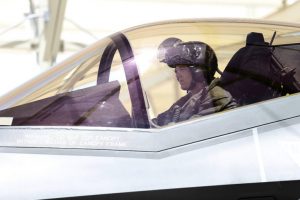2016-09-22 Kampflybloggen (The Combat Aircraft Blog) is the official blog of the Norwegian F-35 Program Office within the Norwegian Ministry of Defence.
The author of this post, Major Morten “Dolby” Hanche, has more than 2200 hours behind him in the F-16, he is a U.S. Navy Test Pilot School graduate, and on 10 November 2015 he became the first Norwegian to fly the F-35.
He now serves as an instructor pilot with the 62nd Fighter Squadron at Luke Air Force Base in Arizona.
This post is an updated version of an article first published in Norwegian.
I finished up writing this article before getting ready to fly another sortie in the F-35.
Based on my own experiences flying the F-35A, I feel that the media´s interpretation of the previous DOT&E report is influenced heavily by unrealistic expectations – something which seems to be a trend.

I don´t see the point in countering every claim that´s being brought up.
First off, it´d make for a very long article.
Secondly, I would not be dealing with the bigger problem, which in my mind is a lack of understanding.
I fully expect the F-35´s most hardened critics to discount this article, regardless of what I write.
However, some may choose to believe my story, based on the fact that I know the airplane and its capabilities as a pilot. I don´t make my claims based on bits and pieces of information, derived from potentially unreliable sources.
They are based on experience actually flying and training with the jet for nearly a year
My goal is to shed some light on airplane development and testing; why we test, what we discover in testing and what a test report may result in.
I write this based on my own experience, both through education at the US Naval Test Pilot School, but more importantly through working with the F-16 and the F-35, both operationally and in test settings….
I´ll start with smartphones, as another example of technology development. Admittedly, phones are somewhat different from a fighter airplane, but there are similarities.
A smartphone is a complex system of systems – just like a fighter jet. The phones keep evolving with both new hard- and software. It is not unheard of therefore that the manufacturers issue updates.
Updates which provide new capabilities, but which also aim to correct previous errors.
According to Wikipedia, Apple released its iOS 9.0 operating system to their iPhones and iPads on 16 September 2015.
The 9.0.1 update was issued already on 23 September, followed closely by the 9.0.2 update on 30 September. Then 9.1 on 21 October and 9.2 on 8 December 2015.
Such a frequent update rate might indicate that not everything worked perfectly from the start.
Still, wouldn´t it be a bit harsh to claim that the phones didn´t work with the first four software versions?
Major Hanche concluded with this key point:
To me, a compelling argument for how well the F-35 works is evident by what we´re able to do in training.
Three weeks back I was part of a four-ship of F-35s.
Our mission was to overcome an advanced airborne threat, while locating and destroying an equally advanced surface based air defense system.
After neutralizing these threats, we were able to destroy four additional targets.
All this prior to receiving the Block 3F capabilities.
Suffice to say that this mission would have been close to suicide with a four-ship of F-16s alone!
For a look at the arrival of software upgradeable combat aircraft, see the following:
The Software-Upgradeable Combat Aircraft: The Case of the P-8
And for the broader context within which Norway has acquired the F-35, see the article by Carl A. Posey in the September 2016 Air and Space Magazine:
http://www.airspacemag.com/military-aviation/norways-air-force-180960362/?no-ist
The Guard at NATO’s Northern Gate
With a new force of F-35 Joint Strike Fighters, Norway readies for Europe’s next threat.
Though the conversation around the restaurant is mostly in Norwegian, you also hear diners chatting in English, a good deal of it concerning aviation. The room is stocked with tech reps tending the flock of F-16s stationed here, and preparing for the Lockheed Martin F-35A Lightning IIs that will soon begin their migration to Norway. The prospect of their arrival has already begun to transform not only this nation’s air force, but every branch of its military…..
“I have been flying the F-35 for quite some years now,” he puts “flying” in air quotes—“in a simulator environment. The F-35 isn’t built for a dogfight. It is very popular to talk about this one-on-one. But [such talk] should die, really. The fight can happen in a decidedly different way than it would in the F-16. One-on-one with guns only doesn’t really matter. You did something dramatically wrong if you ended up in a dogfight” in the F-35.

The Joint Air Power Competence Centre experts maintain that the F-35, like the F-22, has been designed “to engage without being engaged in turn,” and at visual range, that engagement isn’t always a furball. They point out that the F-35 can engage a target that’s behind it, something more traditional fighters can’t do.
No one in Norway seems troubled by the offensive mission the F-35 is designed to fly, or the claim that it will be able to penetrate and survive high-threat environments. “The F-16 has a pretty good offensive capability,” says Aamodt…..
“We control all the radars there are in Norway,” he explains, referring to a string of installations monitoring the country’s airspace and borders. But those radars are quickly becoming obsolete. “We have radars that were developed and delivered in the 1970s. Also some less than 10 years old.” Like so much else in the Norwegian military, replacing them over the next decade is linked to the arrival of the F-35…..
Over the next several years, the much-anticipated covey of F-35As will arrive, bringing new capabilities that will dominate Norwegian military strategy for decades to come. The F-35 will become Norway’s main line of defense, and if called out, demonstrate its strike capability.
Ed Timperlake added this comment about the “right stuff” Norwegian style:
I was a Fighter Pilot with VMFA-451 (F-4Js) and we scrambled to Andoya from MCAS Beaufort in 1972 to deter Russia (then Soviets).
The Norwegian Military across the board that we worked with are world class warriors.

